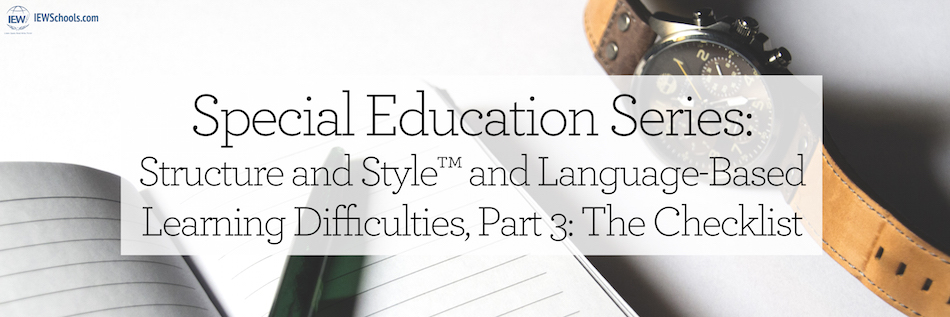
by Linda Mikottis and Jean Nichols
In the previous post in this series, we compared traditional methods for teaching grammar with those used in IEW’s Structure and Style™ process that are more successful and research-based. In this final post, we will explain how the checklist supports special needs students by making writing and revising expectations clear and concrete while simultaneously facilitating student accountability, self-assessment, and independence.
The Checklist: An Effective Multi-purpose Tool
The beauty of the Structure and Style approach for special needs learners centers on the effective use of the checklist, which defines the stylistic techniques a teacher wants to see in a student’s writing. More importantly, it defines them for the student. How many times do teachers attempt to coax a student to write with more detail by asking, “Can you add a little more information here?” or “Can you describe this a little more there?” If the student could do that without guidance, he probably would have done so in the first place! Providing a checklist eliminates the guesswork from writing by clearly spelling out what students need for a complete and successful composition. By practicing only one new stylistic technique at a time on the checklist using the Easy Plus One strategy, students gain confidence in their ability to “sound better” and “feel smarter” in a concrete and highly accessible way.
The student who struggles with writing appreciates the checklist because she knows what the specific assignment is, and she knows when she is finished. She has no need to to wonder if she is doing what the teacher has asked. Everything is on the checklist. Just complete each required item and check them off. Done!
Students who rely on visual cues in order to remember the steps or objectives of an assignment are equally grateful for this tool. They no longer need to rely solely on memory. Some children struggle with short-term memory, others with long-term memory. The checklist addresses both. Assignment goals are well-defined, and expectations are clear, freeing the brain to construct each sentence instead of trying to remember the lesson concepts while simultaneously incorporating the teacher’s instructions. No longer overwhelmed by having too many things to remember, students can relax and be more focused. This builds self-confidence and motivates students to think of themselves as writers.
Clearly, IEW’s Structure and Style method serves students with language-based learning disabilities in three effective and powerful ways:
-
Our method provides a comprehensive, multi-sensory approach to writing that incorporates listening, speaking, reading, and writing. The systematic process of introducing Structure and Style gives students with learning challenges the means—and the confidence—to tackle any writing situation they face. Beginning with the key word outline, they are taught to think sequentially while building vocabulary and English grammar skills. Over time students internalize the process and begin to integrate content, structure, and style to create a complete message.
-
Grammar is taught through the context of writing, which is more effective than first teaching the rules from a grammar book and then expecting students to apply them correctly. Through writing, grammar rules become concrete and immediately applicable and are mastered more quickly.
-
Using a checklist provides the structure and support that students need without the added burden of remembering what is expected while they learn to write. It also provides an appropriately differentiated list of stylistic techniques to be checked off, which results in students becoming more self-reliant and motivated by success. With consistent use of the checklist from grade to grade, students gain a mental toolbox of techniques they can apply to any writing situation.
Whether you serve special needs students in a general education classroom, resource room, or intervention program or individually as a tutor, IEW’s methods and materials will help your students become competent and confident communicators and thinkers. To learn more about using Structure and Style in your classroom or school, please visit our Getting Started with IEW page. There, you can view an introductory webinar and video, learn more about our training options and instructional materials, examine our research studies, and request a proposal for your school or classroom. We look forward to serving you.
Structure and Style is a trademark of the Institute for Excellence in Writing, L.L.C
|
Jean brings 34 years of classroom experience to IEW, having taught grades 1–6 in New York, Virginia, and in California, where she taught sixth-grade language arts in the Rocklin Unified School District. She was introduced to IEW in 2001 when a colleague shared Student Writing Intensive videos at weekly school staff meetings. As a result of student progress and teacher enthusiasm at her school, RUSD brought Andrew Pudewa to Rocklin many times over the next several years to train district teachers, resulting in improved student writing and test scores district-wide. Named Rocklin’s “Elementary Teacher of the Year” in 2001, Jean was also included in the 2004 and 2005 editions of Who’s Who Among America’s Teachers. |
|
 |
Linda Mikottis, BS SP ED, EL ED, and Accomplished IEW Instructor, is probably the least likely writing teacher you will ever meet. Never having learned to write well in school, she was convinced one was either born with the gift of writing or not. After discovering the Institute for Excellence in Writing methodology in 1996, Linda finally learned to write at the age of 34. No longer intimidated by writing, she was determined that others would not grow up as she did. Many of her successful students have been diagnosed with Asperger syndrome, learning disabilities, dyslexia, ADD, and ADHD. Linda now empowers children by empowering teachers through the hope IEW has to offer. |

